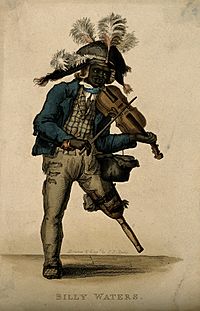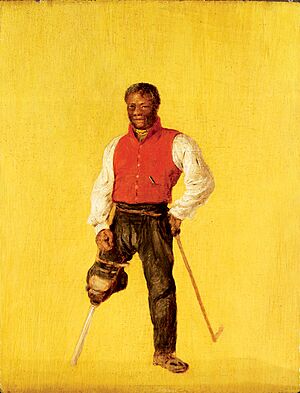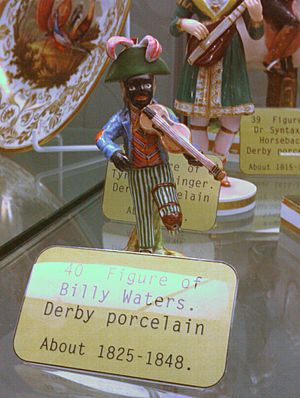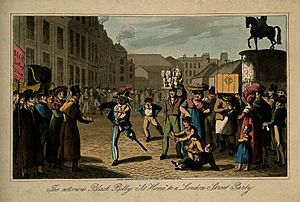Billy Waters (busker) facts for kids
Quick facts for kids
Billy Waters
|
|
|---|---|

Waters by Thomas Lord Busby
|
|
| Born | c. 1778 |
| Died | 1823 St Giles Workhouse, London
|
| Occupation | Beggar, performer |
Billy Waters (around 1778–1823) was a famous street performer in London during the 1800s. He entertained people by singing, playing the violin, and doing funny acts. He became very well-known after appearing as a character in a popular play called Tom and Jerry, or Life in London in 1821.
Who Was Billy Waters?
Billy Waters became known as a street performer in London. He played his violin for people going to the theatre, hoping to earn halfpennies (small coins). It is believed that he was once forced to work without pay in America. However, he later joined the British navy instead.
Billy had a very unique look. He was of African heritage, wore a naval uniform, had a wooden leg, and always carried his violin. He often wore a feathered hat too! He lost his leg while serving as a sailor in the navy, perhaps after falling from a ship's ropes. Other stories say he lost it fighting in the American War of Independence.
Billy had a wife and two children to support. In the 1780s, he would often perform outside the Adelphi Theatre. Billy and his "peculiar antics" (funny ways) became so famous that he was even asked to perform on stage as himself!
His Fame in London
Billy Waters was one of the many interesting people in London who were featured in William Thomas Moncrieff's play, Tom and Jerry, or Life in London. This play came out in 1821 and was based on a popular book by Pierce Egan called Life in London.
Billy was one of about 10,000 people of African heritage living and working in England at that time. He was very poor. It is said that his wooden leg saved him twice from having to do hard labor on a treadmill (a machine used for punishment).
Towards the end of his life, Billy Waters was chosen as the "King of the Beggars" in the area of St Giles. This showed how famous he was and how much his friends respected him. His small navy pension (money from his time in the navy) left him so poor that he had to sell his violin. People even said he would have sold his wooden leg, but it was too worn out to be worth anything.
Billy became sick and had to go into the St Giles' workhouse (a place where poor people could live and work). He died there in 1823, after ten days.
Billy Waters left behind a will written in a poem. One part of it said:
Thus poor Black Billy's made his Will,
His Property was small good lack,
For till the day death did him kill
His house he carried on his back.
The Adelphi now may say alas!
And to his memory raise a stone:
Their gold will be exchanged for brass,
Since poor Black Billy's dead and gone.
Billy's Lasting Impact
After Billy Waters died, artists made figures of him out of porcelain. These were made by famous potteries like those in Staffordshire and Derby porcelain. One of these figures, made in Derby, is now in the Derby Museum. It was created by Edward Keys to compete with cheaper figures from other potteries.
There is also a drawing of Billy Waters by Thomas Lord Busby from his book Costume of the Lower Orders of London. A more realistic painting is thought to be by Sir David Wilkie.
Another porcelain figure looks a lot like an engraving (a type of print) made by George Cruikshank in 1819. This engraving shows Billy Waters entertaining people at a special dinner. It's interesting because in this engraving, Billy is missing the same leg as in the porcelain figures, but in Sir David Wilkie's painting, he is missing the other leg!




